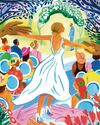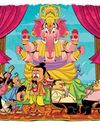
A demon asur nonchalantly twirling a human skull and the blade that took it; the buffalo-headed monster Mahisasur, and his nemesis, the half-man, half-lion Narsimha; a pair of gopis, or milkmaids, waving peacock feathers to catch a polyamorous god's eye; the naked and bloodthirsty goddess Kali, with her many arms and garland of skulls-the dramatis personae of the Hindu cosmos is famously colourful and many-headed. But the selection of wild incarnations stalking the pages of Charles Fréger's book of portraits Aam Aastha offers a glimpse of a more startling, and perhaps deeper, paganism than the narrowing visual imagination of mainstream Hindu iconography proliferating in India today.
While modern Hindu nationalism fosters a state-sponsored religious aesthetic increasingly focussed on gigantic temples and statues, Charles Fréger's meticulously composed images of the 'little traditions' of religious devotion staged by costumed 'folk' artists from more than 60 local cultures across the country, are both strikingly beautiful and quietly unsettling.
Fréger has, it would be fair to say, something of an obsession with ritual costumed performance, or masquerades. He has been working on related themes since at least 2010, in a beguiling series of books including Wilder Mann, on mythic, feral characters of European cultures, Yokainoshima on traditional festival costumes of rural Japan, and Cimarron, on the ritual costumes and characters assumed by descendants of African slaves in the Americas.
Despite the resonance of these earlier projects, Fréger told me that Aam Aastha (which translates as 'common devotions') was "more ambitious" because it focussed on masquerades and dances linked to religion. "This is what distinguishes it from my other projects right from the start," he said. "Here, we depict a wide variety of representations, often tribal, of Buddhist and Hindu deities."
هذه القصة مأخوذة من طبعة May 2024 من Reader's Digest India.
ابدأ النسخة التجريبية المجانية من Magzter GOLD لمدة 7 أيام للوصول إلى آلاف القصص المتميزة المنسقة وأكثر من 9,000 مجلة وصحيفة.
بالفعل مشترك ? تسجيل الدخول
هذه القصة مأخوذة من طبعة May 2024 من Reader's Digest India.
ابدأ النسخة التجريبية المجانية من Magzter GOLD لمدة 7 أيام للوصول إلى آلاف القصص المتميزة المنسقة وأكثر من 9,000 مجلة وصحيفة.
بالفعل مشترك? تسجيل الدخول

From the King's Table to Street Food: A Food History of Delhi
Pushpesh Pant, one of India’s pre-eminent food writers, is back with a comprehensive food history of the capital.

Who Wants Coffee?
It’s bitter—but beloved around the world

Prevent The Pain Of Shingles
You don't have to suffer, as long as you take two important steps

The Best And Worst Diets For Your Heart
Dozens of diets are touted as ‘best’, but it’s easy to lose track of the fact that healthy eating needs to be about overall wellness, not just weight loss.

ME & MY SHELF
Journalist Sopan Joshi has worked in a science and environment framework for nearly three decades. His book Mangifera indica: A Biography of the Mango (Aleph Book Company) synthesizes the sensory appeal of India's favourite fruit with its elaborate cultural roots and natural history. He writes in English and Hindi.

SWITCHED
In 1962, nurses at a small Canadian hospital sent home two women with the wrong babies. Then, 50 years later, their children discovered the shocking mistake.

ECHOES OF THE PAST
A VISIT TO THE ANCIENT BARABAR CAVES IN BIHAR REVEALS A SURPRISING CONNECTION TO A LITERARY CLASSIC

Fathers of the Bride
A young woman finds a unique way to honour the many men who helped her survive her childhood

Fiction's Foresight
British-Bangladeshi author Manzu Islam's works reveal startling parallels to recent political upheavals in Bangladesh, begging the question: Besides helping us make sense of our world, can stories also offer a glimpse into the future?

It Happens ONLY IN INDIA
The Divine Defence Picture this: A tractor in Rajasthan‘s Banswara district,a group of loan agents closing in to seize it and the defaulting farmer and his family standing by.